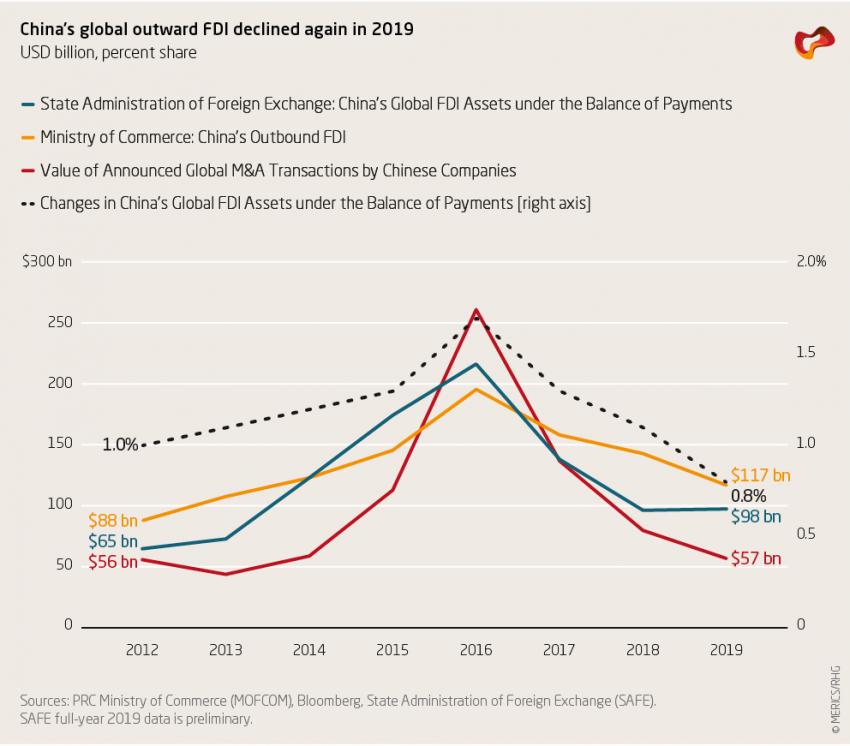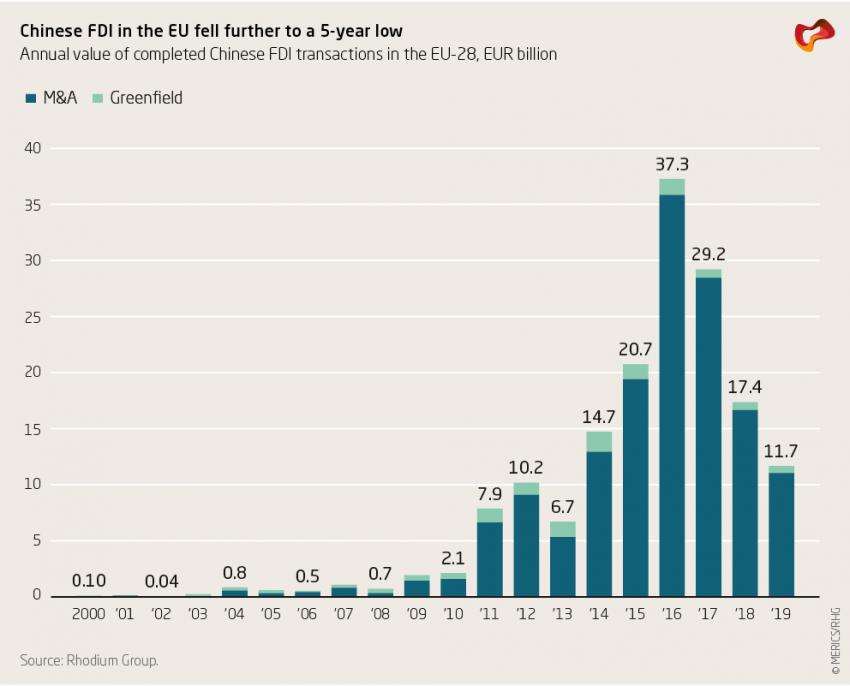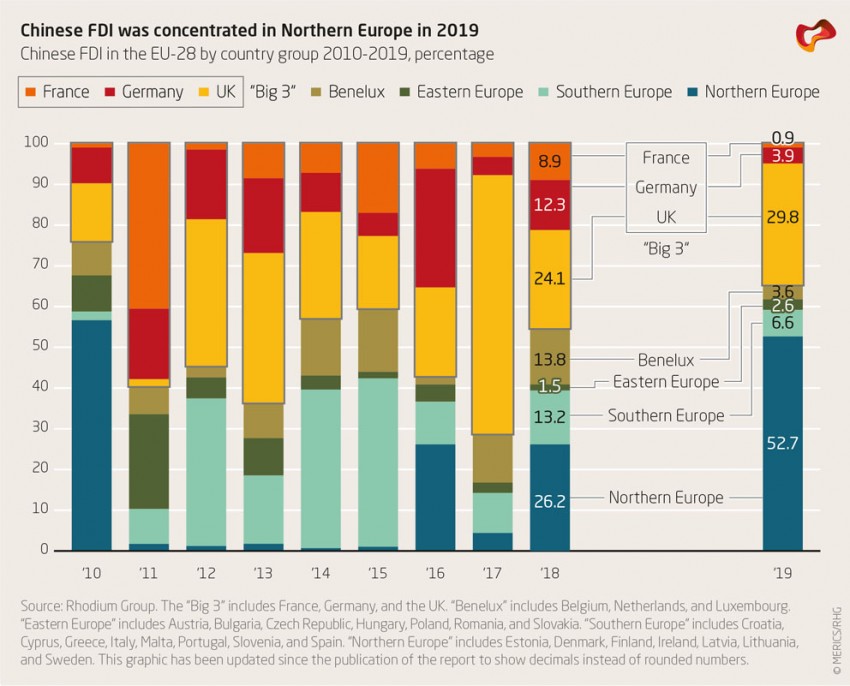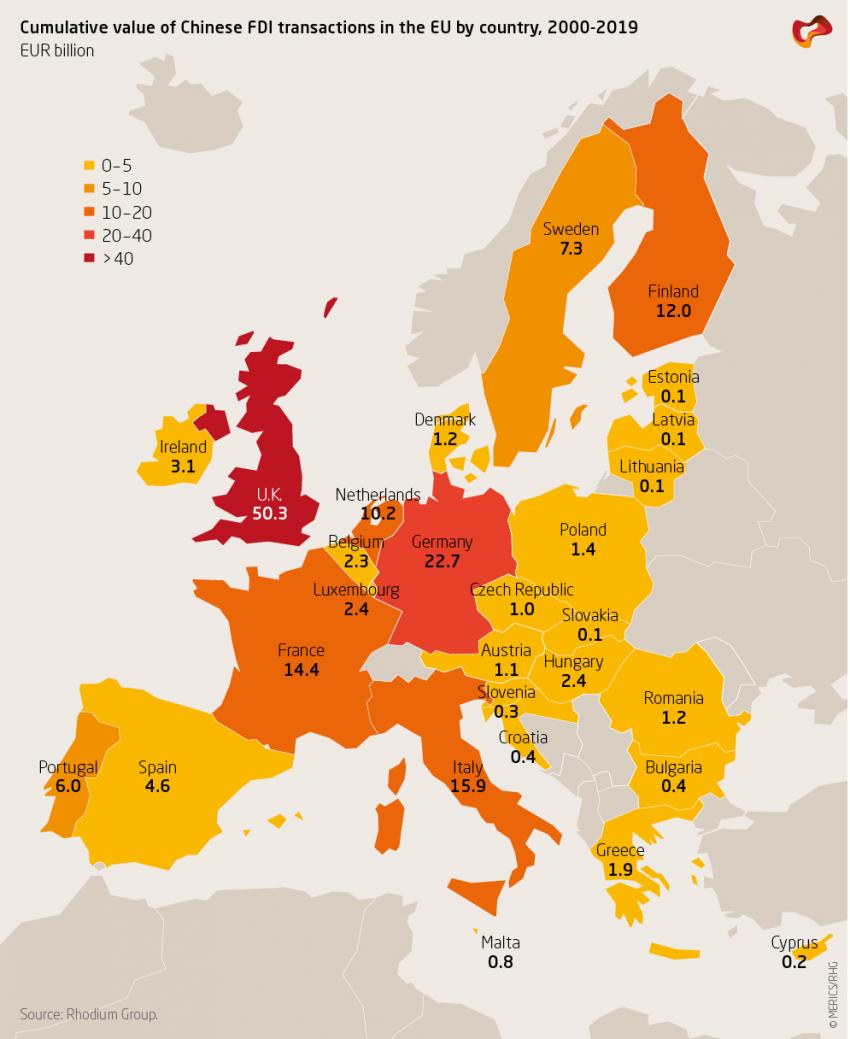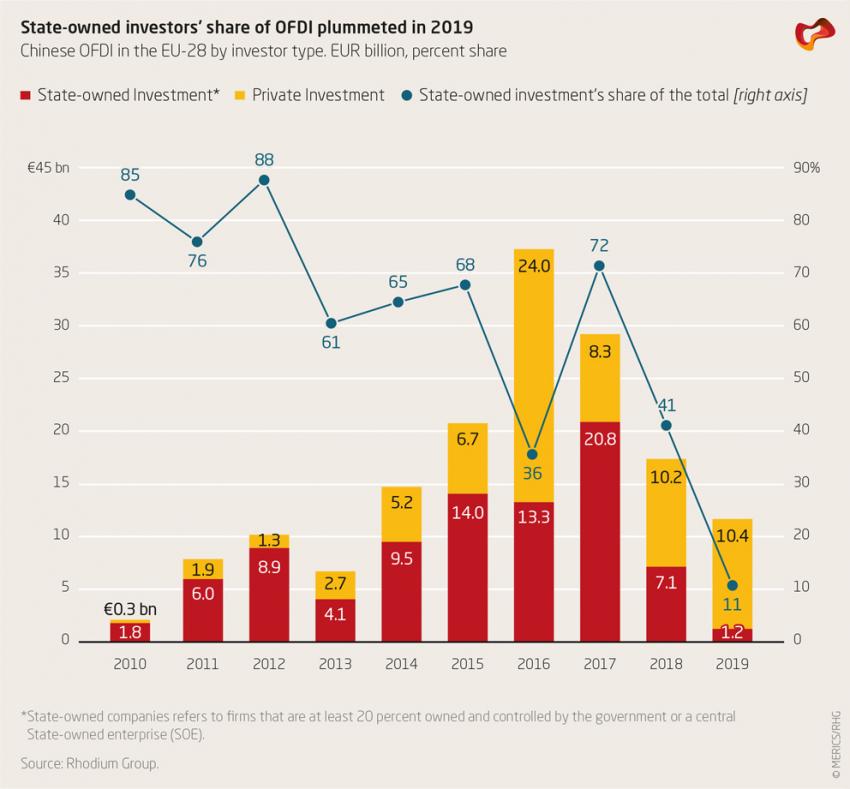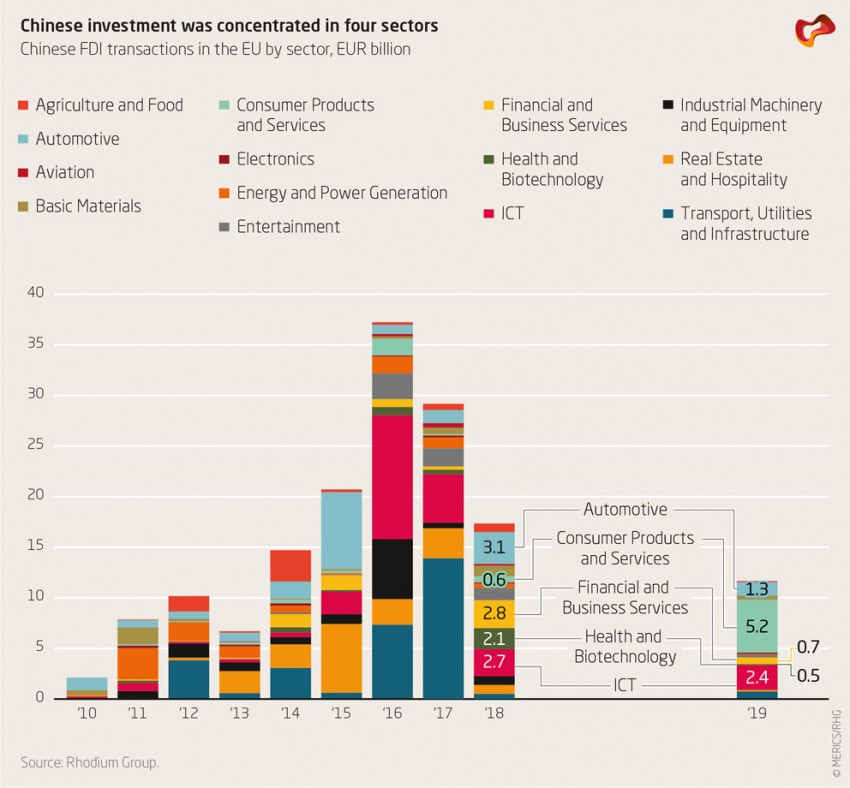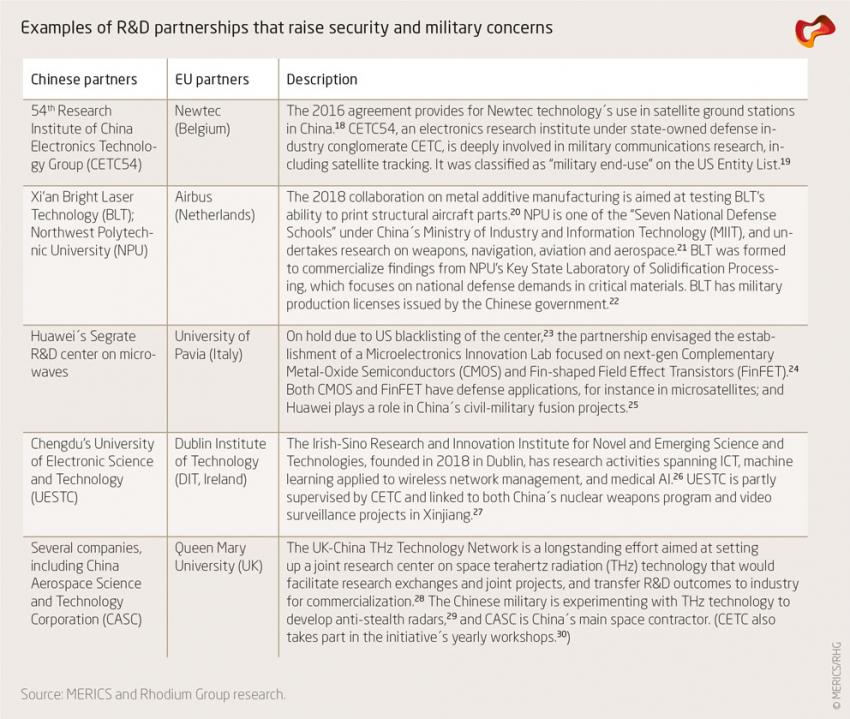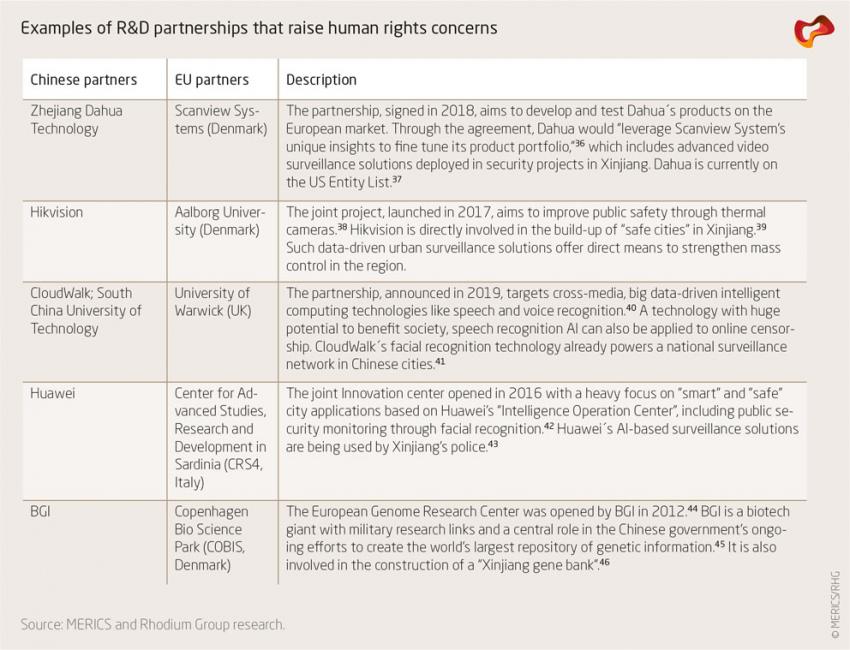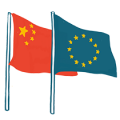

Chinese FDI in Europe: 2019 Update
Special Topic: Research Collaborations
Executive Summary
- Chinese foreign direct investment (FDI) in the European Union (EU) continued to decline in 2019. Chinese FDI transactions in the EU-28 dropped by 33 percent last year, from EUR 18 billion in 2018 to EUR 12 billion in 2019, bringing the total back to 2013 levels. The decline is in line with the downward trajectory of China’s global outbound investment since 2016.
- The geographic and sectoral distribution of Chinese investment in the EU shifted last year. Consumer products and services were the main target for Chinese investors in 2019, overtaking automotive and concentrating 40 percent of investment volume. For the first time since 2010, Northern Europe was the top recipient of Chinese capital, overtaking the “Big 3” (UK, Germany and France).
- The share of state-owned investors plummeted. The proportion of inbound investment coming from China’s state-owned enterprise (SOEs) tanked further to a mere 11 percent of aggregate investment (the lowest level since 2000). Continued administrative controls and financial constraints in China and a changing regulatory environment in Europe contributed the drop.
- As acquisitions and other equity investment have become more difficult, Chinese firms are pursuing alternative ways to interact with European entities. Chinese companies have stepped up research and development (R&D) collaborations with EU companies, universities and governments, among other channels.
- Though most of these partnerships are benign and desirable from a European perspective, some raise important concerns. R&D collaborations are a natural outcome of China´s maturing economy, and the Covid-19 outbreak shows just how crucial they are for fighting global problems. Yet problematic cases exist, including ones that facilitate the transfer of critical and dual-use technologies to China´s military-industrial complex or contribute to the state’s ability to exert mass control over its population.
- Europe needs to do a better job at identifying problematic tie-ups in order to preserve fruitful openness in science and research collaboration. As with investment screening, EU leaders need to find solutions that address a narrow set of concerns while preserving Europe’s economic openness. If policymakers are concerned about critical and sensitive technology transfers to China, or European firms directly or indirectly contributing to human right abuses, then their scrutiny needs to expand beyond equity investment to cover these partnerships. Furthermore, inaction will invite pushback from key allies and OECD partners, risking costly and unnecessary decoupling. To match changing realities, information-sharing mechanisms, export controls and other monitoring tools all need adaptation. Researchers, whether at companies or universities or individuals, must invest in understanding China’s firms and policies better, to identify and mitigate against risks.
Introduction
China’s outbound investment trajectory has changed profoundly in the past five years. Outbound investment peaked in 2016, after a decade of double-digit growth, and has been on a downward trajectory ever since. Outflows dropped precipitously in 2017 and 2018 after Beijing imposed administrative restrictions to curb “irrational” capital outflows. In 2019, China’s global outbound FDI (OFDI) dropped back to 2014 levels (Figure 1). The substantial drop does not mean that Chinese companies have lost their appetite for the global economy. Instead, it mostly reflects changes in several domestic variables that have made it more difficult for firms to raise funding and get approval for overseas investment.
While equity investment has fallen, other types of interactions with overseas markets have shown resilience or even expanded, notably collaborations in research and development (R&D) between Chinese and foreign firms, universities or government, both within and outside of China. Europe has seen many such tie-ups in the recent past.
Building on a long-standing collaboration between Rhodium Group and MERICS, this report analyses China’s changing footprint in the EU. In Section 1, we take stock of Chinese outbound FDI into the 28 member states of the European Union in 2019 (Section 1).1 In Section 2, we examine how Chinese firms have diversified their European footprint through R&D collaborations , scrutinize the implications for European actors and ask what is required from policymakers.
1. Chinese FDI in Europe: 2019 Trends
In line with global trends, Chinese FDI in the EU-28 declined markedly in the past few years after reaching a peak of EUR 37 billion in 2016. There were three main reasons for this decline: tighter administrative controls in China on outward investment from 2017; a clampdown on the “irrational” acquisitions of a few key investors; and a deleveraging campaign that reduced Chinese firms’ ability to finance overseas assets purchases. This downward trend continued in 2019.
1.1 Chinese FDI in the EU is back to 2013/2014 levels
In 2019, the combined value of completed Chinese FDI transactions in the EU dropped again to EUR 12 billion, down 33 percent from EUR 18 billion in 2018 (Figure 2).2 The split between greenfield investments and acquisitions, by value, was similar to previous years: around five percent of total investment went to greenfield projects, though they were about 40 percent of single transaction numbers. Greenfield investment may form a greater proportion of total value in the next few years as several newly announced large greenfield projects are breaking ground and progressing (for example, Wuxi Biologics’ manufacturing base and vaccine plant in Ireland and CATL’s battery factory in Germany).
1.2 Northern Europe overtakes the “Big Three” as the main destination of Chinese FDI
In 2019, the geographic distribution of Chinese investment in the EU changed noticeably (Figure 3). The share of the “Big Three” economies (UK, Germany, France), which have traditionally received the most Chinese capital, dropped to 34,6 percent of total investment in 2019, compared to 45 percent in 2018 and 71 percent in 2017. Investment into all three countries declined, though the UK held up best. The UK remained the second largest recipient of Chinese FDI by volume in 2019, mostly due to Jiangsu Shagang’s acquisition of additional stakes in data center firm Global Switch (worth £1.8 billion, or EUR 2 billion). It also topped the list for the number of single transactions.
Northern Europe supplanted the “Big Three” as the top region for the first time since 2010, receiving 53 percent of all Chinese investment. This was due mainly to a few large M&A deals, including Anta’s acquisition of Amer for EUR 4.6 billion (which made Finland the top recipient country for Chinese investment in 2019) and China Evergrande’s investment in NEVS for EUR 830 million (making Sweden the third highest recipient country in 2019). Investment into Ireland also increased and is set to grow further as two large greenfield factories by Wuxi Biologics get underway over the next few years.
Southern Europe and Benelux both saw their shares decline to less than 10 percent. Eastern Europe’s share rose from 2 percent in 2018 to 3 percent in 2019, a level still well below the region’s weight in the GDP of the EU (10.1 percent in 2019) Investment into Romania jumped to EUR 230 million in 2019 due to several sizable acquisitions and the establishment of CGN’s new joint venture company with Nuclearelectrica, which could lead to further significant greenfield investments down the road.
1.3 Investment by China’s state-owned companies plunged to 11 percent of the total
State-owned companies have traditionally dominated Chinese investment in Europe; they accounted for more than 70 percent of total investment in 2010-2015. Their share subsequently began to fluctuate. In 2016, it dropped below 50 percent as Chinese private enterprises went on a huge global buying spree. In 2018, their share dipped below 50 percent again as China’s restrictions on OFDI impacted both SOEs and private firms. In 2019, the weight of SOEs tanked further to a mere 11 percent of aggregate investment, the lowest level since 2000. SOE’s decreased share again reflected the weight of significant acquisitions by private players. Other possible influences include China’s ongoing restrictions, and more defensive European policies and a changing regulatory environment within the EU. The trend goes beyond Europe. Chinese SOEs’ share of Chinese FDI also fell to 7 percent in the US, though the country has traditionally seen lower levels of investment from them.
1.4 The industry mix is shifting toward consumer products and services; ICT remains strong
The sectoral mix of Chinese investment in Europe was quite concentrated in 2019, far more so than in the previous year. In 2019, four sectors received more than 80 percent of total Chinese investment within the EU.
The consumer products and services sector was the top recipient by far, attracting more than 40 percent of the total. However, this was due to one mega deal: Anta’s acquisition of the Finnish sporting goods group Amer for EUR 4.6 billion. It was the fourth largest Chinese acquisition in the EU since 2000. Another notable acquisition was Haier’s EUR 475 million takeover of the Italian domestic appliance manufacturer Candy. The preeminence of consumer products and services in the industry mix in 2019 was likely due to the non-politicized nature of the sector and predominantly private-sector profile of Chinese investors, which triggered less scrutiny and resistance from regulators in both China and Europe.
Despite increased European scrutiny around Chinese investment in tech-related sectors, ICT remained the top sector in 2019 in terms of single transactions (with 20 percent of all transactions) and came second in terms of volume (EUR 2.4 billion). The biggest deal was Jiangsu Shagang Group’s increased shareholding in UK-based Global Switch, which owns, operates and develops data centers in Europe and Asia. The acquisition was begun in 2016 and has not faced opposition in the UK despite the sensitive nature of the target. Other deals included Shenzhen Goodix Technology Co Ltd’s acquisition of NXP Semiconductors’ (Netherlands) voice and audio business, and Alibaba’s acquisition of Data Artisans, a German big data startup. In 2018, Goodix had already acquired the German cellular IoT intellectual property company CommSolid to support the development of its System-on-Chips (SoCs) solutions, targeted at new applications for IoT and smart devices.3
With EUR 1.3 billion worth of investment, automotive came third: the biggest deal was China Evergrande’s investment in Sweden’s NEVS. And transport, utilities and infrastructure came fourth with EUR 0.8 billion in investment. The biggest deal in that sector was CIC’s acquisition of National Grid’s stake in UK’s Cadent gas network, the largest natural gas distribution network in the UK. Cadent’s gas network would likely qualify as critical infrastructure under the EU’s new investment screening regulation, though this did not prevent the deal from going through.
The persistence of ICT as a top target for Chinese investment shows Chinese firms’ continued interest in European technology companies and know-how. FDI flows have receded over the past three years but deal-making remains strong, often consisting of smaller acquisitions below EUR 100 million.
1.5 Outlook
The global Covid-19 pandemic will deeply impact global capital flows, including China’s outbound investment. The shutdown of large parts of China’s economy in February and March has already had a negative effect on deal-making in the first three months of 2020. Domestically, the volume of deals announced dropped by more than half in Q1 compared to previous years. Early data points indicate that the first quarter of 2020 will show the lowest outbound deal volume from China in almost ten years.4
Yet the crisis is also creating buying opportunities in Europe and elsewhere. Markets around the world plummeted as the pandemic spread. At their lowest point in March, Germany’s DAX 30 and France’s CAC 40 had both lost over 30 percent. Past crises saw Chinese firms acquire discounted assets around the globe. In 2008-09, they targeted vital commodities for China’s development, such as iron and nickel ore, and oil. Immediately after the 2012-13 Euro crisis, Chinese investors bought a string of strategic European assets on the cheap.
However, an opportunistic Chinese buying spree in the wake of the Covid-19 crisis is less likely than in 2009 and 2013. The factors that have caused significant falls in Chinese OFDI over the past three years will persist. Chinese firms face liquidity pressure, given the slowing domestic economy, and China’s government is unlikely to loosen capital controls any time soon. In addition, Europe’s response to the crisis has been swift and powerful, including the ECB’s EUR 750 billion asset purchase program and targeted measures by national governments to support domestic enterprises. Compared to 2008/2009, European firms should be in a better position to weather a temporary recession and liquidity crisis without having to take on a “White Knight” investor.
Finally, the overhaul of investment screening regimes across Europe has put regulators in a much better position to intervene in foreign takeovers compared to 2008/2009 (see last year’s report). Many nations have reformed their tool box and the European Commission has issued further screening guidelines to ensure member states protect critical European assets and technology during the coronavirus crisis.5 In short, Chinese outbound investment is likely to increase during the remainder of the year from a very low base, but a return to boom levels of 2015-2016 levels is unlikely.
2. Special Topic: Assessing Sino-European R&D partnerships
While Chinese equity investments in the EU-28 have dropped, non-equity types of activity have grown rapidly recently. Joint R&D is an increasingly important dimension of China’s economic engagement with many OECD economies, and a natural next step for technology collaboration. Recently, there has been an expansion in R&D collaborations between Chinese firms and European entities.
These interactions can bring substantial benefits to the European actors involved, as they allow for the collaborative creation of technologies and know-how, new products and services. The Covid-19 outbreak has also illustrated the importance of cross-border R&D collaboration for tackling global challenges like pandemics and climate change.
At the same time, R&D partnerships often provide Chinese parties with access to potentially sensitive European assets, sometimes without European counterparts even noticing. In 2018, the EU began revising its foreign acquisitions review toolbox, in large part due to concerns around security risks from Chinese investment (see our last joint report).6 These efforts have so far focused on FDI and other equity investments, while R&D collaborations still largely escape regulatory scrutiny and have received comparatively scant attention.
This Special Topic section analyzes the current trends in Sino-European R&D partnerships. While recognizing the many benefits to Europe, it also presents examples of collaborations that raise concerns due to security and human rights risks. It concludes by highlighting implications for businesses and policymakers.7
2.1 Trends and types of R&D collaborations
China’s maturing economy has naturally proliferated the channels of interaction between Chinese firms and European entities. Cross-border R&D collaborations are a common and growing feature of international technology flows.8 This report does not aim to provide a comprehensive picture of growing R&D ties between Europe and China. Instead, it focuses on R&D activities involving Chinese firms in Europe and presents anecdotal evidence of their growth – and of some of the concerns they raise. The report covers three main types of R&D interactions between Chinese firms and European stakeholders:
- R&D collaborations between Chinese and European companies. These arrangements are widespread and serve as a key channel for private cross-border technological exchanges
- Partnerships between Chinese firms and European universities and other academic institutions, which have grown rapidly in recent years
- Chinese firms’ involvement in projects supported by or involving European governments and EU institutions. The EU and China have strong, longstanding research and innovation (R&I) ties, which are most visible in Chinese corporate involvement in Horizon 2020, the EU´s flagship research funding scheme.9
Other highly relevant forms of R&D collaboration are not covered in this report. They include partnerships between Chinese and EU governmental entities10 or academic institutions,11 or between European firms and non-corporate Chinese institutions. Grants and fellowships involving individual researchers are also omitted, though they are an important regulatory blind spot. And in addition to EU-based collaborations, R&D tie-ups are also multiplying in China. For example, several member states have signed innovation agreements with China’s government, ranging from informal pledges to formal partnerships. Many European companies have also been expanding their R&D activities in China. Though not reviwed in this report, all these types of transactions feature prominently in the diversifying picture of EU-China technology exchanges.12
2.2 Balancing benefits and risks: Why Europe needs a more clear-eyed view of research collaboration with China
The importance of cross-border collaboration in critical scientific fields such as health research is amply demonstrated by the deal struck between the German biotech firm BioNTech and Shanghai Fosun Pharmaceutical to test an experimental Covid-19 vaccine, backed by a USD 135 million investment from the Chinese group.13
More generally, European stakeholders can benefit greatly from R&D partnerships with Chinese firms. In a globalized world, innovation is an increasingly cross-border activity. Despite enduring weaknesses in innovation, China now outspends the EU in R&D expenditure as a share of GDP,14 and is home to highly innovative companies, so the case for collaboration a compelling one. Not only is joint R&D critical for EU companies to tailor their products and services to Chinese partners and clients, it is also an opportunity to tap into China´s talent pool and hi-tech industrial clusters.
However, R&D collaborations granting Chinese players access to state-of-the-art European technologies could also have a long-term detrimental impact on European economic competitiveness, in a similar way to Chinese acquisitions of EU strategic tech assets. Many European stakeholders still tend to underestimate the Chinese government´s top-down, strategic approach to foreign R&D collaboration, which is geared towards attracting or leveraging talents and technology from abroad. China’s coordinated plans covering industrial policy and technological autonomy mean that some R&D partnerships are specifically targeting sectors such as emerging technologies where China’s government seeks to create firms that can become global leaders, or to gradually replace foreign technologies with indigenous ones.15
Two other key concerns stand-out, aside from economic and competitiveness considerations. First, some of these partnerships could lead to the transfer of dual-use technologies to China´s military-industrial complex. Second, R&D collaborations can contribute to enhancing the Chinese state’s ability to exert mass control over its population. European actors need to pursue a clear-eyed approach to R&D collaborations with Chinese entities to avoid such risks.
2.3 Security and military considerations
R&D partnerships are not covered by existing European FDI screening regulations or export controls, yet they can lead to the leakage of sensitive technologies and know-how. The potential for transfer of dual-use technologies to China’s industrial-military complex is a key concern.
There are numerous cases of European companies engaging in R&D collaborations with Chinese entities directly owned by or linked to the People´s Liberation Army (PLA), including around sensitive and potentially dual use technologies (see table 1). No member state seems to be immune, and technologies involved range from satellite technologies to critical materials and aerospace.
Many European academic institutions, too, exhibit a lack of awareness about the security implications of some of their R&D tie-ups, coupled with poor due diligence on Chinese partners. Recent reports document how Chinese researchers sponsored by PLA-affiliated universities have tapped European universities for cutting-edge research in defense-relevant areas.16 We find that Chinese firms with ties to the CCP or its military have also ramped up their partnerships with European universities and other academic institutions. Some of these arrangements involve basic research in technologies that could be relevant for the defense applications of new materials, artificial intelligence, or communications technologies.
Even EU government institutions often neglect or ignore the security risks of research collaborations with Chinese counterparts. One early example was China’s participation in the EU’s Galileo satellite system, which allowed the Chinese parties (including some of China’s largest military aerospace manufacturers) to retain ownership of resulting technologies and intellectual property after Beijing left the partnership. China has since built its dual-use satellite navigation system, Beidou, which rivals Galileo and boosts the PLA´s geolocation and communications capabilities.17
2.4 Human rights concerns
In addition to supporting China’s military modernization, some of these collaborations can also undermine some EU core values and foreign policy objectives, such as the promotion of human rights. We find that some Sino-European R&D partnerships directly or indirectly contribute to the ability of China’s state and CCP authorities to intensify mass social control (see Table 2). Several joint projects target frontier surveillance technologies, some of which are being or could in future be deployed to increase Beijing’s sway over Uighur and other minorities in Xinjiang. In some cases, the Chinese partners have been found to directly support intrusive hi-tech policing efforts in Xinjiang and elsewhere in China.
There are serious reputational risks for European parties, as well as potential non-compliance with existing human rights provisions for businesses in some EU member states. EU firms and universities found to be cooperating with Chinese partners who support human rights abuses must be prepared to face strong public opinion backlashes. Even for European governments, some joint research activities are in direct contradiction to EU foreign policy on China – especially concerns voiced around the CCP´s large-scale human rights abuses.
A widely reported case is the collaboration between Siemens and the China Electronics Technology Group Corporation (CETC) on intelligent manufacturing solutions, electronics equipment and information security, signed in 2018.31 State-run military contractor CETC, which also controls 42 percent of the surveillance technology giant Hikvision (currently on the US Entity List32), is behind the “Integrated Joint Operation Platform,” a mass surveillance app used by police in Xinjiang to track and target minorities.33 Siemens has credibly denied directly contributing to CETC’s surveillance technology build-up. However, its smart manufacturing solutions, which aim to improve the clients´ data collection capabilities, may strengthen CETC’s capabilities in adjacent fields, as it is difficult to prevent internal technology diffusion within CETC.
Sino-European R&D partnerships involving Chinese genome sequencing companies, some of which are involved in building DNA databases in China, are also of concern. The New York Times first documented the forced collection of DNA samples in Xinjiang, undertaken to perfect the racial profiling and surveillance of minorities.34It also unveiled the role of the German Max Planck Society in sponsoring Chinese scientists whose research on DNA phenotyping directly supported those efforts.35
2.5 Implications for European businesses and policymakers
Europe suffers from a lack of debate around the growth of R&D partnerships with Chinese entities and the associated challenges.Researchers, civil society and policymakers in other OECD economies (notably the US47 and Australia48) have already attempted to create more transparency around problematic cases and make recommendations on how to address regulatory gaps. In Europe, policymakers in Brussels and European capitals are gradually starting to recognize related risks. The European Commission´s DG Research and Innovation and the German government, for instance, are making preliminary efforts to promote greater information-sharing on research and innovation (R&I) activities with Chinese entities. Yet much remains to be done. While most Chinese firms’ R&D partnerships with European entities are likely to be benign and beneficial for the European parties involved, EU leaders need to find solutions that address a narrow but critical set of concerns while preserving Europe’s principles of economic openness. Here are a few initial recommendations in that direction:
First, if European leaders are serious about restricting China’s access to dual-use and sensitive technologies and know-how, alternative channels beyond equity investment will need to be scrutinized more closely. This will require a stock-take of export control reforms currently under discussion, to assess whether these are enough to mitigate existing concerns. Guidelines for R&D collaborations with Chinese entities are also needed, covering all relevant European stakeholders (industry, academia, local public authorities).
Second, addressing the issue in a timely and effective manner will help avoid knee jerk reactions from the national security community and other domestic interest groups, and make sure the door stays open for non-problematic collaborations. For some parties, it will be tempting to discard much, or all, of the current scientific and technological engagement with China on precautionary security grounds. Inaction will also invite pushback from the US and other key military allies.
Third, to craft effective policy, EU policymakers will need up-to-date and objective data on new channels of innovation and technological interaction. They will need to define what they view as problematic technology transfer, and hence as their own set of “critical technologies,” and take stock of the scope of such activities in Europe to understand what policy prescriptions are required. Identifying problematic activities will require actionable information to be shared across countries on the scale and scope of China’s R&D activities in the EU.
Fourth, companies will have to ramp-up their own due diligence efforts. European companies need to invest further in understanding Chinese firms’ corporate ownership structures and how their Chinese counterparts may well be embedded within China’s top-down strategic plans. Awareness is needed of their linkages with state entities, civil-military fusion and techno-nationalist innovation plans, and any implications for human rights transgressions deemed wholly unacceptable in Europe.
Finally, European authorities will need to coordinate their response with “like-minded” countries. Other nations, including the US, are moving more aggressively to safeguard against potential technology leakage. Given their strong technological links with other OECD nations and companies, EU firms could be impacted if they do not grasp these developments. Such a backlash could offset the potential benefits that China’s broadening economic footprint can bring to Europe in non-sensitive sectors. Coordination with other OECD partners will therefore be crucial to avoid an unaffordable and unnecessary decoupling.
- Endnotes
-
1| Data presented in this report still includes the United Kingdom, which was still an EU member state during the whole of 2019.
2| For a detailed description of the data methodology, please refer to the appendix in Hanemann, Thilo and Huotari, Mikko (2015). “Preparing for a New Era of Chinese Capital: Chinese FDI in Europe and Germany.” MERICS and Rhodium Group. June. https://www.merics.org/sites/default/files/2017-09/COFDI_2015_EN.pdf. Accessed: April 6, 2020.
3| Burt, Chris (2019). “Goodix acquires cellular IP company CommSolid.” BiometricUpdate.com. February 26. https://www.biometricupdate.com/201802/goodix-acquires-cellular-ip-company-commsolid. Accessed: April 4, 2020.
4| Authors’ calculation based on data on announced M&A transactions with PRC buyers and targets from Bloomberg; downloaded March 25, 2020.
5| European Commission (2020). “Coronavirus: Commission Issues Guidelines to Protect Critical European Assets and Technology in Current Crisis.” March 25. https://trade.ec.europa.eu/doclib/press/index.cfm?id=2124. Accessed: April 6, 2020.
6| Hanemann, Thilo et al. (2019). “Chinese FDI in Europe: 2018 Trends and Impact of New Screening Policies.” MERICS and Rhodium Group. March. https://www.merics.org/sites/default/files/2019-03/190311_MERICS-Rhodium%20Group_COFDI-Update_2019.pdf. Accessed: April 6, 2020.
7| Neither MERICS nor Rhodium Group researchers are specialized defense analysts and thus do not possess the expertise to assess the extent of technology that was transferred in these cases or the value of that technology to China. In this report, we flag transactions that we believe meet the initial criteria to deserve further expert investigation.
8| The OECD shows for example that the share of patents involving cross-border collaboration as of 2013 had already doubled over the past 30 years to around 20%, and that of scientific publications with international co-authors had tripled to about the same percentage. OECD (2013). Regions and Innovation Collaborating across Borders. Paris: OECD Publishing.
9| This happens mainly through a “Co-Funding Mechanism” administered by the European Commission and China´s Ministry of Science and Technology (MOST). While China-based partners are sponsored by MOST, Europe-based Chinese firms also directly benefit from EU funds. As of 2018, Huawei, for example had received EUR 11.5 million for ICT R&D projects, including on 5G. European Commission, DG Research and Innovation (2018). “Roadmap for EU-China S&T Cooperation.” October. https://ec.europa.eu/research/iscp/pdf/policy/cn_roadmap_2018.pdf#view=fit&pagemode=none. Accessed: April 6, 2020.
10| See for example the 2018 strategic collaboration between the Portuguese and Chinese governments, which led to the creation of a joint laboratory (“STARlab”) for building microsatellites for oceanographic research. Macauhub (2018). “Portugal and China Create Laboratory for Space and the Oceans. November 8. https://macauhub.com.mo/2018/11/08/pt-portugal-e-china-criam-laboratorio-para-o-espaco-e-oceanos/. Accessed: April 6, 2020.
11| One example is collaborations on artificial intelligence and drone technology between three Irish universities – Trinity College Dublin, University College Dublin and University College Cork – and China’s Tsinghua and Southeast Universities. Mooney, John (2019). “Irish Colleges Links with Chinese ´Cyber-Spy´ Universities Spark Concerns.” The Times. September 8. https://www.thetimes.co.uk/article/irish-colleges-links-with-chinese-cyber-spy-universities-spark-concern-sdg7rbmf3. Accessed: April 6, 2020. Not only do these involve dual-use technologies that China’s military has shown an increased keenness towards, but Tsinghua University made clear that it intends to link efforts towards a “national AI superpower strategy” with the “national strategy of military-civilian integration”. See Kania, Elsa B. (2018). “Tsinghua´s Approach to Military-Civil Fusion in Artificial Intelligence.” Battlefieldsingularity.com. July 5. https://www.battlefieldsingularity.com/post/tsinghua-s-approach-to-military-civil-fusion-in-artificial-intelligence. Accessed: April 6, 2020.
12| For an illustration of these agreements, see Huotari, Mikko et al. (2020). “Managing Economic Cooperation and Competition with China.” MERICS. March. https://www.merics.org/en/managing-economic-cooperation-and-competition-with-china. Accessed: April 6, 2020. Besides providing channels for joint R&D projects between European governmental institutions and Chinese firms in the EU, these agreements also facilitate R&D collaboration between European firms and universities and Chinese corporates, for instance through joint innovation labs and technology transfer centers (like the Italy-China Technology Transfer Center, or CITTC), business promotion fairs, and joint startup incubators. For examples related to the innovation partnership between the Chinese and the Italian governments, see China-Italy Technology Transfer Center 中意技术转移中心 (2020). 中心简介(About Us). https://www.cittc.org.cn/. Accessed: April 6, 2020; Xinhua (2018). “19 Cooperation Agreements Signed at China-Italy Innovation Week in Milan.” December 5. http://www.xinhuanet.com/english/europe/2018-12/05/c_137652319.htm. Accessed: April 6, 2020.
13| Burger, Ludwig (2020). “BioNTech in China Alliance with Fosun over Potential Coronavirus Vaccine.” Reuters. March 16. https://www.reuters.com/article/us-biontech-fosunpharma-vaccine-collabor/biontech-in-china-alliance-with-fosun-over-potential-coronavirus-vaccine-idUSKBN2130O5. Accessed: April 6, 2020.
14| At 2.2% for China, compared to the EU-28´s 2% in 2018. OECD (2020). “Main Science and Technology Indicators.” Last Update: February. https://www.oecd.org/sti/msti.htm. Accessed: April 6, 2020.
15| For a detailed description of China´s tech transfer infrastructure, see Hannas, Wm. C. and Chang, Huey-meei (2019. “China´s Access to Foreign AI Technology.” Center for Security and Emerging Technology. September. https://cset.georgetown.edu/wp-content/uploads/CSET_China_Access_To_Foreign_AI_Technology.pdf. Accessed: April 6, 2020. For a case study of Sino-German R&D cooperation in the field of smart manufacturing and Industry 4.0, see Zenglein, Max J. and Holzmann, Anna (2019). “Evolving Made in China 2025.” MERICS. July. https://www.merics.org/en/papers-on-china/evolving-made-in-china-2025.
16| https://www.aspi.org.au/report/picking-flowers-making-honey. Accessed: July 6, 2020.
17| Lague, David (2013). “In Satellite Tech Race, China Hitched a Ride from Europe.” Reuters. December 22. https://www.reuters.com/article/breakout-beidou/special-report-in-satellite-tech-race-china-hitched-a-ride-from-europe-idUSL4N0JJ0J320131222. Accessed: April 6, 2020.
18| Newtec (2016). “Newtec and CETC54 Enter New Partnership.” Press Release. November 14. https://www.newtec.eu/frontend/files/userfiles/files/PR/Newtec%20Press%20Release_CETC54-Cooperation__English%20Version__2016-11-14(2).pdf. Accessed: April 6, 2020.
19| This is a list of foreign organizations prohibited from receiving some or all items covered under US Export Administration Regulations (EAR). Cave, Danielle and Thomas-Noone, Brendan (2017). “CSIRO Cooperation with Chinese Defense Contractor Should Raise Questions.” The Guardian. June 2. https://www.theguardian.com/australia-news/2017/jun/03/csiro-cooperation-with-chinese-defence-contractor-should-raise-questions. Accessed: April 6, 2020.
20| Bright Laser Technologies 铂力特 (2018). “From Supplier to Joint R&D Partners, Bright Laser Technologies together with Airbus Enter a New Era of Aerospace Application with Metal Additive Manufacturing.” December 27. http://e.xa-blt.com/home/news/detail?id=73. Accessed April 6, 2020.
21| Zhongguo Mingxiao Zizhu Zhaosheng Wang中国名校自主招生网 (2019). 国内高校联盟: 国防七子的今生往世 (National Alliance of Colleges and Universities: The Seven Sons of National Defense). May 6. http://www.mxzzzs.com/news/100797.html. Accessed: April 6, 2020; ASPI International Cyber Policy Center (2019). “Northwestern Polytechnical University.” In “China Defense Universities Tracker.” ASPI. November 2019. https://unitracker.aspi.org.au/universities/northwestern-polytechnical-university/. Accessed: April 6, 2020.
22| Angliviel, Marcel et al. (2019). “Open Arms.” C4ADS. https://www.c4reports.org/open-arms. Accessed: April 6, 2020.
23| Biondi, Andrea (2019). “Huawei: nella lista nera USA anche il centro ricerche di Segrate” (Huawei: Segrate Research Center also on US Blacklist.” Il Sole 24 Ore. August 21. https://www.ilsole24ore.com/art/huawei-lista-nera-usa-anche-centro-ricerche-segrate-ACyT5Zf. Accessed April 6, 2020.
24| Huawei (2019). “Huawei continua a investire in Italia, annunciato il Microelectronics Innovation Lab realizzato in collaborazione con l’Università di Pavia” (Huawei Keeps Investing in Italy, Microelecronics Innovation Lab in Collaboration with the University of Pavia Announced.” July 15. https://e.huawei.com/it/news/it/2019/20190715_Huawei_Microelectronics_Innovation_Lab. Accessed: April 6, 2020.
25| Kania, Elsa B. (2019). “Why China´s Military Wants to Beat the US to a Next-Gen Cell Network.” Defense One. October 23. https://www.defenseone.com/ideas/2019/01/why-chinas-military-wants-beat-us-next-gen-cell-network/154009/. Accessed April 6, 2020.
26| China Daily (2018). “UESTC to Establish Research Institute with Dublin Institute of Technology.” October 23. http://www.chinadaily.com.cn/regional/2018-10/23/content_37123887.htm?from=singlemessage&isappinstalled=0. Date Accessed: April 6, 2020.; Gorey, Colm (2018). “Irish Universities Open AI Research Doors to China with Signing of Agreements.” IDA Ireland. November 2. https://www.idaireland.com/newsroom/irish-universities-open-ai-research-doors-to-china. Accessed: April 6, 2020.
27| Joske, Alex (2019). “The China Defence Universities Tracker.” Australian Strategic Policy Institute. November 25. https://www.aspi.org.au/report/china-defence-universities-tracker. Date Accessed: April 6, 2020. Accessed: April 6, 2020.
28| Innovation China-UK (2014). “UK-China THz Technology Network.” Event Report. September. http://www.icukonline.org/knowledge/previousevents.shtml. Accessed: April 6, 2020.
29| Liu Xuanzun (2019). “China Develops Anti-Stealth Radars.” Global Times. March 18. http://www.globaltimes.cn/content/1142562.shtml. Accessed: April 6, 2020.
30| Queen Mary University of London (2014). “UCMMT 2014 - 7th Europe/UK-China Millimetre Waves and Terahertz Technology Workshop.” Event Summary Report. http://www.icukonline.org/news/UCMMT%202014%20Report%20_final.pdf. Accessed: April 6, 2020; 张宇 Zhang Yu (2019). 英国/欧洲-中国毫米波与太赫兹技术国际会议2019日程 (UK-Europe-China Workshop on Millimetre Waves and THz Technologies.) Zhi Hu. August 14. https://zhuanlan.zhihu.com/p/78154388. Date Accessed: April 6, 2020.
31| Siemens (2018). “Siemens Seals Strategic Cooperation Agreement with China Electronics Technology Group Corporation.” https://w1.siemens.com.cn/news_en/news_articles_en/6780.aspx. Accessed: April 6, 2020.
32| Bureau of Industry and Security (2020). “Supplement No. 4 to Part 744 of the Export Administration Regulations.” March 16. https://www.bis.doc.gov/index.php/policy-guidance/lists-of-parties-of-concern/entity-list. Accessed: April 6, 2020.
33| Human Rights Watch (2019). “China’s Algorithms of Repression.” May 1. https://www.hrw.org/report/2019/05/01/chinas-algorithms-repression/reverse-engineering-xinjiang-police-mass-surveillance. Accessed: April 6, 2020.
34| Wee, Sui-Lee (2019). “China Uses DNA to Track Its People, With the Help of American Expertise.” New York Times. Feburary 21. https://www.nytimes.com/2019/02/21/business/china-xinjiang-uighur-dna-thermo-fisher.html. Date Accessed: April 6, 2020; Wee, Sui-Lee and Paul Mozur (2019). “China Uses DNA to Map Faces, With Help from the West.” New York Times. December 3. https://www.nytimes.com/2019/12/03/business/china-dna-uighurs-xinjiang.html. Accessed: April 6, 2020.
35| Ibid.
36| Security World Market (2018). “Dahua and Scanview Agree Strategic Partnership.” July 19. https://www.securityworldmarket.com/int/News/Business-News/dahua-technology-secures-strategic-partnership-with-scanview-systems. Accessed: April 6, 2020.
37| Swanson, Ana and Paul Mozur (2019). “U.S. Blacklists 28 Chinese Entities Over Abuses in Xinjiang.” New York Times. October 7. https://www.nytimes.com/2019/10/07/us/politics/us-to-blacklist-28-chinese-entities-over-abuses-in-xinjiang.html. Accessed: April 6, 2020.
38| Security World Market (2017). “Hikvision Thermal Cameras Secure the Danish Waterfront.” August 10. https://www.securityworldmarket.com/int/News/Business-News/hikvision-thermal-cameras-secure-the-waterfront-in-aalborg-denmark1. Accessed: June 6, 2020.
39| 本刊讯 Ben Kanxun. 海康威视中标乌鲁木齐高新区平安城市治安防控PPP项目 (HikVision Wins Bid to Build PPP Safe City in Urumqi.) iXueShu. https://www.ixueshu.com/document/e4859208ffe87b81449ca05ad6d4351b318947a18e7f9386.html. Accessed: April 6, 2020.
40| Phoenix Chinese News and Entertainment Channel (2018). 云从科技与全球百强名校建立国际科技合作项目 (Yuncong Technology Establishes International Technology Cooperation Project with the World's Top 100 Famous Schools.”) http://inews.ifeng.com/58400588/news.shtml. May 22. Accessed: April 6.; Li, Xinyi (2019). “CLOUDWALK AI Smart Exhibition Hall Opened to the Public.” iChongQing. Arpril 20. https://www.ichongqing.info/2019/04/20/cloudwalk-ai-smart-exhibition-hall-opened-to-the-public/. Accessed: April 6, 2020.
41| Deng, Iris (2019). “This State-Backed AI Unicorn Has Helped Chinese Police Arrest 10,000 Criminals.” South China Morning Post. March 28. https://www.scmp.com/tech/start-ups/article/3003686/state-backed-ai-unicorn-has-helped-chinese-police-arrest-10000. Accessed: April 6, 2020.
42| Joint Innovation Center. http://www.jicsardegna.it/en/. Accessed: April 6, 2020; Huawei (2018). “Announced New Projects of the Joint Innovation Center of Huawei and CRS4 for Smart & Safe City.” November 7. https://www.huawei.com/en/press-events/news/2018/11/huawei-joint-innovation-center-crs4-smart-safe-city. Accessed: April 6, 2020; Dall’Ava, Matteo (2019) “Come Cagliari si sta trasformando in una smart city” (“How Cagliari is Transforming into a Smart City.”) Wired. Feburary 18. https://www.wired.it/internet/tlc/2019/02/18/cagliari-smart-city-huawei/. Accessed April 6, 2020.
43| Cave, Daniel et al. (2019). “Mapping more of China’s tech giants: AI and surveillance.” Australian Strategic Policy Institute. November. https://www.aspi.org.au/report/mapping-more-chinas-tech-giants. Accessed: April 6, 2020.
44| Copenhagen Capacity (2012). “BGI from China opens Genome Research Center in Copenhagen.” February 17. https://www.copcap.com/news/bgi-from-china-opens-genome-research-center-in-copenhagen. Accessed: April 6, 2020.
45| Kania, Elsa B. (2019). “Weaponizing Biotech: How China’s Military Is Preparing for a ‘New Domain of Warfare.’” Defense One. August 14. https://www.defenseone.com/ideas/2019/08/chinas-military-pursuing-biotech/159167/. Accessed: April 6, 2020.
46| Urumqi Hi-Tech (2016). 华大基因正式入驻乌鲁木齐高新区(新市区) (BGI Enters Urumqi High-Tech Zone.) July 27. http://www.uhdz.gov.cn/info/1020/17563.htm. Accessed: April 6, 2020.
47| Segal, Stephanie and Gerstel, Dylan (2019). “Research Collaboration in an Era of Strategic Competition.” Center for Strategic and International Studies. September. https://www.csis.org/analysis/research-collaboration-era-strategic-competition. Accessed: April 6, 2020.
48| Boyd, Alan (2019). “Australia, China Tech Ties Face Tough New Scrutiny.” Asia Times. October 15. https://asiatimes.com/2019/10/australia-china-tech-ties-face-tough-new-scrutiny/. Accessed: April 6, 2020.

